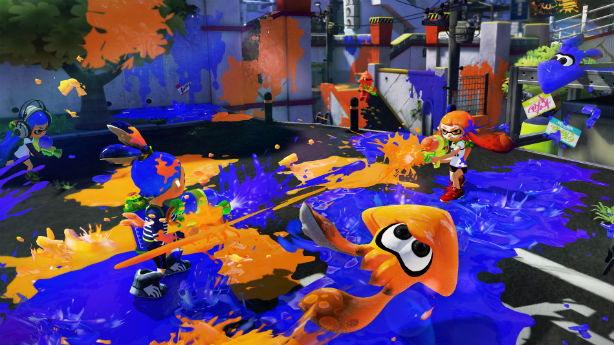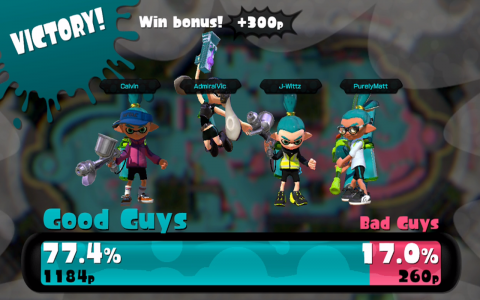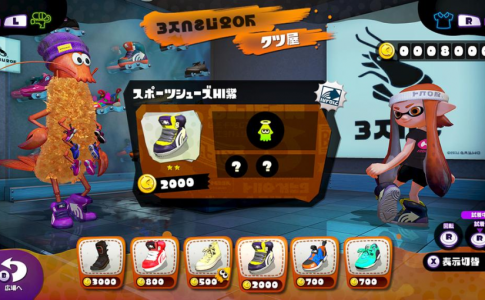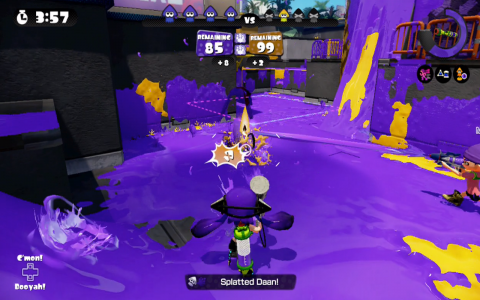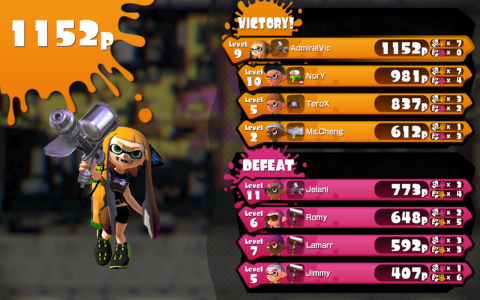Following the success of the Metroid Prime series, Nintendo fans have been waiting for their take on the online shooter. While that never happened on the Wii, Nintendo is trying their luck with Splatoon on the Wii U. With multiple game modes, a couple of maps, a single player campaign, plenty of unlockables, amiibo support and all the typical Nintendo charm, Splatoon has the makings of a great game. However, with this being their first attempt at an online shooter, a lack of voice chat, and other things, will Splatoon be the great game we think it is or will it fail to live up to the hype?
Splatoon starts with a brief introduction to the world. You’re told that the giant lightfish has mysteriously disappeared, meet the Squid Sisters, hear about the games and are introduced to some of the places/characters in the town. After this you’re prompted to join multiplayer, but the best place to start is the single player campaign.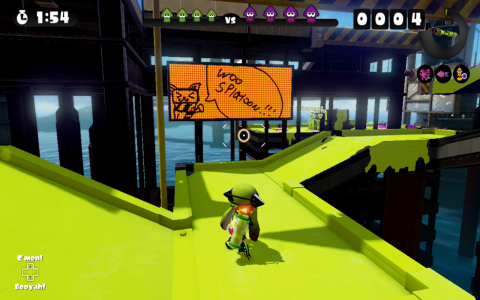
At the start of the campaign you’ll meet Cap’n Cuttlefish, a crazy looking old man who claims he is trying to save the giant lightfish and needs your help for this thankless quest. As the set up might suggest, the story isn’t that exciting and the plot doesn’t really advance beyond the set up until the very end. Even though the story is quite forgettable, the single player campaign ultimately accomplishes its goals.
Like a lot of online shooters, the single player exists to get you familiar with the mechanics of Splatoon and expand the world. A lot of levels force you to master squid mode, develop tactics to counteract the enemy and finding all the scrolls requires a keen eye for details. By the end of the 30 or so level campaign, you should have a pretty good idea of how to play and are ready to tackle the online multiplayer.
The first mode you can tackle is turf war, which is a competitive mode where you have to have more ground covered in your paint than the enemy team. The challenge becomes finding the best tactic for your team. Some teams like to slowly take over one area at a time and both teams simply trade capture points until the end, where as other teams will try to hold areas or focus on areas the enemy has control over. Regardless of which tactic you use, the interesting thing is how Splatoon handles combat.
Unlike most competitive shooters, Splatoon is geared towards aggressive gameplay tactics, instead of defensive ones. This is partly because getting splatted (killed) doesn’t give the enemy any points beyond where the ink that explodes from your body lands and distracts them with your mess, but also because Splatoon doesn’t seem interested in individual success. There doesn’t seem to be an option to see your splat/splatted (kill/death) ratio, accuracy or any of that and ranked battles focus solely on winning/losing. So outside of personal pride, there isn’t a reason to be concerned with your splat/splatted ratio if you win the match.
After playing a couple of matches and hitting level four, you’ll be able to start using the stores in the city. Each store has its own unique NPC and style attached, with the cosmetic items changing once every day. Cosmetic items come in various tiers and looks, with higher tiered ones costing more, but giving you additional perks. These perks are unlocked by gaining experience while wearing the clothes, with all secondary perks being random. This can be frustrating for some, since it can take an indefinite amount of time to get the right build, but it gives you something to constantly work towards. The remaining shops are the black market and weapon shop. Now the black market is interesting because it adds an element of social interaction to the city. The basic idea is if you see someone wearing something you want, then you can “order” it and then purchase it or at least a version of it the next day. You can only do this once a day, but still an interesting element.
As for the weapon shop, there are a number of guns you can buy that unlock as you continue to level up. Each weapon fills the role of your standard guns, such Splattershot being assault rifle, Dynamo Roller is a shotgun, splattershot Jr. equals a submachine gun and the Splat Charger snipes. Over time you unlock them with different builds or sub perks like the ability to become a Kraken, shoot a rocket, etc and even some later weapons let you to create your ideal build. These minor details are important to note, since some weapons are geared towards objectives, where as other weapons are combat based. It’s important to know these differences, since odds are you won’t beat a combat weapon with an objective one and vice versa. This offers varied gameplay that you can’t simply predict/plan for.
Upon reaching level 10 you’ll unlocked ranked battles, which is a more intense mode where the outcome of battle affects your standing. Here the only thing that matters is winning and the more you win, the higher your rank will be, though losing will also tank your rank. The amount you go up or down depends on the difference between your rank and theirs, but in my experience you generally get more for a win than you lose for a loss. Plus leveling up gives you a slight buffer; so don’t worry about holding your rank forever.
Rank battles also have a new gameplay mode called Splat Zone. As you might have guessed, Splat Zone is basically King of the Hill and is far more intense than Turf War. The idea is simple, you and your team needs to hold one or more zones by having the majority of the zone your color and keeping the other team from getting it. What makes this mode so intense is that it centralizes all the combat.
Every game of Splat Zone that I played had both teams giving their all to come out victorious. This means you should expect to splatted and expect it often, but this is also part of the fun. Unlike Turf War, Splat Zone pushes teamwork and rewards proper tactics. Naturally it’s a shame that Splatoon lacks voice chat, as this is the one mode that would be much better with it, but since all the objectives are straightforward, most people should have an idea what to do. Best or maybe worse of all, this mode features sudden death. To do it the losing team needs to have control and the match will continue until the enemy gets control or the losing team surpasses the winning teams score. During those moments things get far more intense, though this is also when Splatoon is at its most thrilling.
Despite all the praise, Splatoon still has a couple of shortcomings. Arguably the biggest problem, besides the lack of voice chat, is the fact that you can’t do anything besides play mini-games when looking for a match. I found the only way to quit was to turn off the system and it can be boring looking for people and be unable to change your build. Another issue are the “featured maps.” Instead of letting you play all the maps at the same time, each mode has two maps that you can play on until the featured set change (every couple of hours). When they change you also get a notification to watch the Squid Sister briefing explaining what changed. All these things can be fixed in the future, but for now they’re quite annoying.
 For a first attempt at a competitive shooter, Splatoon is quite impressive. Sure the game could be better or have more going on, but that doesn’t stop Splatoon from being an enjoyable experience. I can honestly say it’s the first competitive multiplayer game I truly enjoyed playing in like four years. The fact that Splatoon pushes teamwork and objective victories instead of personal success is welcome and the aggressive style makes a more thrilling experience than what you typically see in a competitive shooter. In the end, if you’re looking for a fun game to play with friends or just want a fast paced multiplayer experience, you can’t go wrong with Splatoon.
For a first attempt at a competitive shooter, Splatoon is quite impressive. Sure the game could be better or have more going on, but that doesn’t stop Splatoon from being an enjoyable experience. I can honestly say it’s the first competitive multiplayer game I truly enjoyed playing in like four years. The fact that Splatoon pushes teamwork and objective victories instead of personal success is welcome and the aggressive style makes a more thrilling experience than what you typically see in a competitive shooter. In the end, if you’re looking for a fun game to play with friends or just want a fast paced multiplayer experience, you can’t go wrong with Splatoon.
[Editor’s Note: Splatoon was reviewed on Nintendo WII U platform. The game was provided to us by the publisher for review purposes.]

